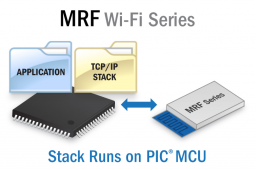Overview
The Microchip TCP/IP Stack provides a foundation for embedded network applications by handling most of the interaction required between the physical network port and your application. It includes modules for several commonly used application layers, including HTTP for serving web pages, SMTP for sending e-mails, SNMP for providing status and control, Telnet, TFTP, Serial-to-Ethernet and much more. In addition, the stack includes light-weight and high-performance implementations of the TCP and UDP transport layers, as well as other supporting modules such as IP, ICMP, DHCP, ARP, and DNS.
Microchip offers a free licensed TCP/IP stack optimized for the PIC18, PIC24, dsPIC33 and PIC32 microcontroller families. The stack is divided into multiple layers, where each layer accesses services from one or more layers directly below it. As specifications, many of the TCP/IP layers are “live”, in the sense that they not only act when a service is requested, but also when events like time-out or new packet arrival occurs.
The TCP/IP stack is modular in design and written in the 'C' programming language. It follows the TCP/IP (Internet) protocol suite. The stack currently supports the TCP and UDP transport layer modules, the IPv4 (and part of the ICMP) Internet Layer modules, the ARP link layer modules, and a variety of application layer modules. Most of the Media Access Control link layer functionality is provided by the hardware MAC/PHY chips used with the stack.
Microchip’s TCP/IP stack includes the following key features:
- Supported Protocols: ARP, IP, ICMP, UDP, TCP, DHCP, SNTP, SMTP, HTTP, FTP, TFTP
- Socket support for TCP and UDP
- Secure Sockets Layer (SSL)
- NetBIOS Name Service
- DNS – Domain Name System
- Ethernet Device Discovery

Documentation
|
Title
|
Document Category
|
|||
|---|---|---|---|---|
| Help files for MLA v2015-08-10 | Miscellaneous | Download | ||
| Release notes for MLA v2015-08-10 | Miscellaneous | Download | ||
| Microchip MRF24W Getting Started Guide for MRF24WB0MA/B, MRF24WG0MA/B for MLA v5 | Supporting Collateral | Download |